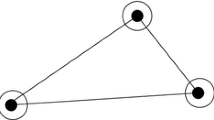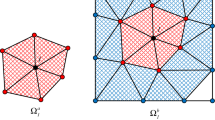Abstract
A quasi-convex reproducing kernel approximation is presented for Galerkin meshfree analysis. In the proposed meshfree scheme, the monomial reproducing conditions are relaxed to maximizing the positivity of the meshfree shape functions and the resulting shape functions are referred as the quasi-convex reproducing kernel shape functions. These quasi-convex meshfree shape functions are still established within the framework of the classical reproducing or consistency conditions, namely the shape functions have similar form as that of the conventional reproducing kernel shape functions. Thus this approach can be conveniently implemented in the standard reproducing kernel meshfree formulation without an overmuch increase of computational effort. Meanwhile, the present formulation enables a straightforward construction of arbitrary higher order shape functions. It is shown that the proposed method yields nearly positive shape functions in the interior problem domain, while in the boundary region the negative effect of the shape functions are also reduced compared with the original meshfree shape functions. Subsequently a Galerkin meshfree analysis is carried out by employing the proposed quasi-convex reproducing kernel shape functions. Numerical results reveal that the proposed method has more favorable accuracy than the conventional reproducing kernel meshfree method, especially for structural vibration analysis.




































Similar content being viewed by others
References
Nayroles B, Touzot G, Villon P (1992) Generalizing the finite element method: diffuse approximation and diffuse elements. Comput Mech 10:307–318
Belytschko T, Lu YY, Gu L (1994) Element-free Gakerkin methods. Int J Numer Meth Eng 37:229–256
Duarte CAM, Oden JT (1996) H-p clouds and h-p meshless method. Numer Methods Partial Differ Equ 12:673–705
Onate E, Idelsohn S, Zienkiewicz OC, Taylor RL (1996) A finite point method in computational mechanics: applications to convective transport and fluid flow. Int J Numer Meth Eng 39:3839–3866
Atluri SN, Zhu T (1998) A new meshless local Petrov-Galerkin (MLPG) approach in computational mechanics. Comput Mech 22:117–127
De S, Bathe KJ (2000) The method of finite spheres. Comput Mech 25:329–345
Monaghan JJ (1992) Smoothed particle hydrodynamics. Ann Rev Astron Astrophys 30:543–574
Liu WK, Jun S, Zhang YF (1995) Reproducing kernel particle methods. Int J Numer Methods Fluids 20:1081–1106
Liu WK, Li S, Belytschko T (1997) Moving least square reproducing kernel method: (I) methodology and convergence. Comput Methods Appl Mech Eng 143:113–154
Li S, Liu WK (1996) Moving least-square reproducing kernel method. Part II fourier analysis. Comput Methods Appl Mech Eng 139:159–193
Chen JS, Han W, You Y, Meng X (2003) A reproducing kernel method with nodal interpolation property. Int J Numer Meth Eng 56:935–960
Liu WK, Han W, Lu H, Li S, Cao J (2004) Reproducing kernel element method. Part I: theoretical formulation. Comput Methods Appl Mech Eng 193:933–951
Sukumar N, Moran B, Belytschko T (1998) The natural element method in solid mechanics. Int J Numer Meth Eng 43:839–887
Liu GR, Gu YT (2000) A local radial point interpolation method (LRPIM) for free vibration analyses of 2-D solids. J Sound Vib 246:29–46
Kansa EJ (1992) Multiqudrics-a scattered data approximation scheme with applications to computational fluid dynamics-I. Surface approximations and partial derivatives. Comput Math Appl 19:127–145
Chen JS, Hu W, Hu HY (2008) Reproducing kernel enhanced local radial basis collocation method. Int J Numer Meth Eng 75:600–627
Gu L (2003) Moving kriging interpolation and element-free Galerkin method. Int J Numer Meth Eng 56:1–11
Sukumar N (2004) Construction of polygonal interpolants: a maximum entropy approach. Int J Numer Meth Eng 61:2159–2181
Arroyo M, Ortiz M (2006) Local maximum-entropy approximation schemes: a seamless bridge between finite elements and meshfree methods. Int J Numer Meth Eng 65:2167–2202
Wu CT, Park CK, Chen JS (2011) A generalized approximation for the meshfree analysis of solids. Int J Numer Meth Eng 85:693–722
Melenk JM, Babuška I (1996) The partition of unity finite element method: basic theory and applications. Comput Methods Appl Mech Eng 139:289–314
Belytschko T, Kronggauz Y, Organ D, Fleming M (1996) Meshless methods: an overview and recent developments. Comput Methods Appl Mech Eng 139:3–47
Liu WK, Chen Y, Jun S, Chen JS, Belytschko T, Pan C, Uras RA, Chang CT (1996) Overview and applications of the reproducing kernel particle methods. Arch Comput Methods Eng 3:3–80
Atluri SN, Shen SP (2002) The meshless local Petrov-Galerkin method. Tech Science Press, Duluth
Babuška I, Banerjee U, Osborn JE (2003) Survey of meshless and generalized finite element methods: a unified approach. Acta Numer 12:1–125
Li S, Liu WK (2004) Meshfree particle methods. Springer, New York
Huerta A, Belytschko T, Fernández-Méndez S, Rabczuk T (2004) Meshfree methods. Encycl Comput Mech 1:279–309
Nguyen VP, Rabczuk T, Bordas S (2008) Meshless methods: a review and computer implementation aspects. Math Comput Simul 79:763–813
Liu GR (2009) Mesh free methods: moving beyond the finite element method, 2nd edn. CRC Press, Boca
Zhang X, Liu Y, Ma S (2009) Meshfree methods and their applications. Adv Mech 39:1–36
Sukumar N, Wright RW (2007) Overview and construction of meshfree basis functions: from moving least squares to entropy approximants. Int J Numer Meth Eng 70:181–205
Sukumar N, Wets RB (2007) Deriving the continuity of maximum-entropy basis functions via variational analysis. SIAM J Optim 18:914–925
Yaw LL, Sukumar N, Kunnath SK (2009) Meshfree co-rotational formulation for two dimensional continua. Int J Numer Meth Eng 79:979–1003
Rosolen A, Millán D, Arroyo M (2010) On the optimum support size in meshfree methods: a variational adaptivity approach with maximum entropy approximants. Int J Numer Meth Eng 82:868–895
Ortiz A, Puso M, Sukumar N (2010) Maximum-entropy meshfree method for compressible and near-incompressible elasticity. Comput Methods Appl Mech Eng 199:1859–1871
Millán D, Rosolen A, Arroyo M (2011) Thin shell analysis from scattered points with maximum-entropy approximants. Int J Numer Meth Eng 85:723–751
Ortiz A, Puso M, Sukumar N (2011) Maximum-entropy meshfree method for incompressible media problems. Finite Elem Anal Des 47:572–585
Quaranta G, Kunnath SK, Sukumar N (2012) Maximum-entropy meshfree method for nonlinear static analysis of planar reinforced concrete structures. Eng Struct 42:179–189
Rosolen A, Peco C, Arroyo M (2013) An adaptive meshfree method for phase-field models of biomembranes. Part I: approximation with maximum-entropy approximants. J Comput Phys 249:303–319
Greco F, Sukumar N (2013) Derivatives of maximum-entropy basis functions on the boundary: theory and computations. Int J Numer Meth Eng 94:1123–1149
Wu CT, Hu W (2011) Meshfree-enriched simplex elements with strain smoothing for the finite element analysis of compressible and near-incompressible solids. Comput Methods Appl Mech Eng 200:2991–3010
Wu CT, Koishi M (2012) Three-dimensional meshfree-enriched finite element formulation for micromechanical hyperelastic modeling of particulate rubber composites. Int J Numer Meth Eng 81:1127–1156
Wu CT, Hu W, Chen JS (2012) A meshfree-enriched finite element method for compressible and near-incompressible elasticity. Int J Numer Meth Eng 90:882–914
Hu W, Wu CT, Koishi M (2012) A displacement-based nonlinear finite element formulation using meshfree-enriched triangular elements for the two-dimensional large deformation analysis of elastomers. Finite Elem Anal Des 50:161–172
Cyron C, Arroyo M, Ortiz M (2009) Smooth, second order, non-negative meshfree approximants selected by maximum entropy. Int J Numer Meth Eng 79:1605–1632
González D, Cueto E, Doblaré M (2010) A higher-order method based on local maximum entropy approximation. Int J Numer Meth Eng 83:741–764
Rosolen A, Millán D, Arroyo M (2013) Second-order convex maximum entropy approximants with applications to high-order PDE. Int J Numer Meth Eng 94:150–182
Bompadre A, Perotti LE, Cyron C, Ortiz M (2012) Convergent meshfree approximation schemes of arbitrary order and smoothness. Comput Methods Appl Mech Eng 221:83–103
Sukumar N (2013) Quadratic maximum-entropy serendipity shape functions for arbitrary planar polygons. Comput Methods Appl Mech Eng 263:27–41
Liu WK, Jun S, Li S, Adee J, Belytschko T (1995) Reproducing kernel particle methods for structural dynamics. Int J Numer Meth Eng 38:1655–1679
Liu WK, Jun S (1998) Multiple-scale reproducing kernel particle methods for large deformation problems. Int J Numer Meth Eng 41:1339–1362
Li S, Liu WK (1998) Synchronized reproducing kernel interpolant via multiple wavelet expansion. Comput Mech 21:28–47
Li S, Liu WK (1999) Reproducing kernel hierarchical partition of unity, Part I: formulations. Int J Numer Meth Eng 45:251–288
Li S, Liu WK (1999) Reproducing kernel hierarchical partition of unity, part II: applications. Int J Numer Meth Eng 45:289–317
Chen JS, Pan C, Wu CT, Liu WK (1996) Reproducing kernel particle methods for large deformation analysis of nonlinear structures. Comput Methods Appl Mech Eng 139:195–227
Chen JS, Pan C, Wu CT (1997) Large deformation analysis of rubber based on a reproducing kernel particle method. Comput Mech 19:211–227
Chen JS, Pan C, Roque CMOL, Wang HP (1998) A Lagrangian reproducing kernel particle method for metal forming analysis. Comput Mech 22:289–307
Chen JS, Yoon S, Wang HP, Liu WK (2000) An improved reproducing kernel particle method for nearly incompressible finite elasticity. Comput Methods Appl Mech Eng 181:117–145
Timoshenko SP, Goodier JN (1970) Theory of elasticity, 3rd edn. McGraw, New York
Acknowledgments
The support of this work by the National Natural Science Foundation of China (11222221) is gratefully acknowledged.
Author information
Authors and Affiliations
Corresponding author
Appendix
Appendix
In this appendix, the nodal numberings and locations for the first non-uniform discretizations of Figs. 19, 30, and 34 are listed for reference (Figs. 37, 38, 39; Tables 1, 2, 3).
Nodal numberings for the rod problem with non-uniform discretization (Fig. 19)
Nodal numberings for the membrane problem with non-uniform discretization (Fig. 30)
Nodal numberings for the cantilever beam problem with non-uniform discretization (Fig. 34)
Rights and permissions
About this article
Cite this article
Wang, D., Chen, P. Quasi-convex reproducing kernel meshfree method. Comput Mech 54, 689–709 (2014). https://doi.org/10.1007/s00466-014-1022-4
Received:
Accepted:
Published:
Issue Date:
DOI: https://doi.org/10.1007/s00466-014-1022-4







